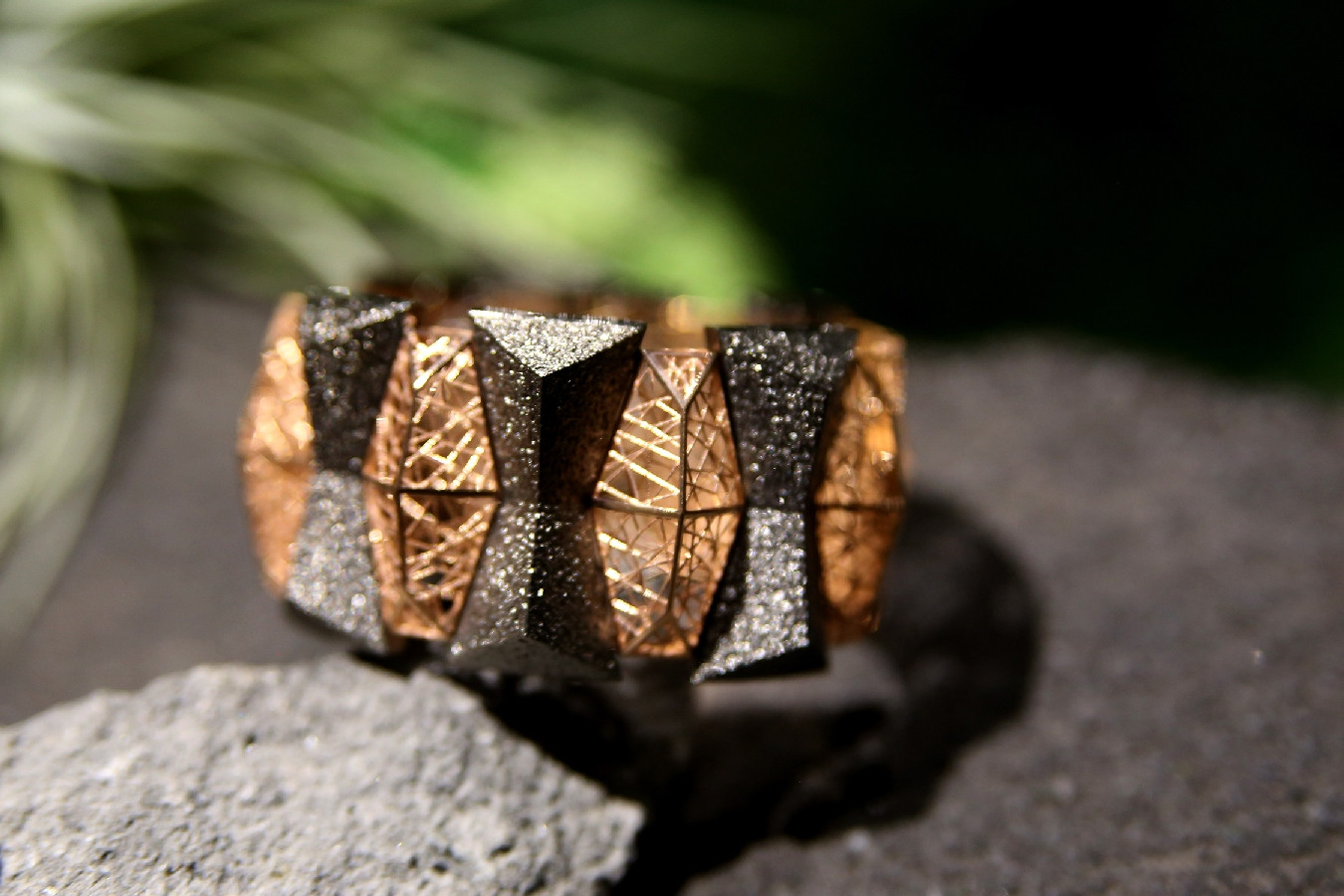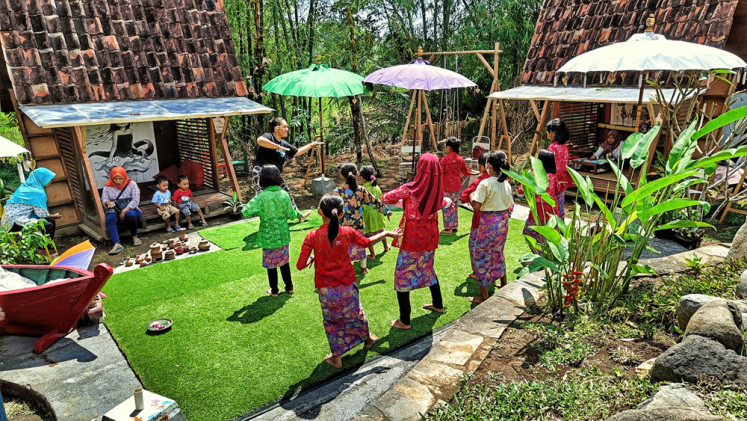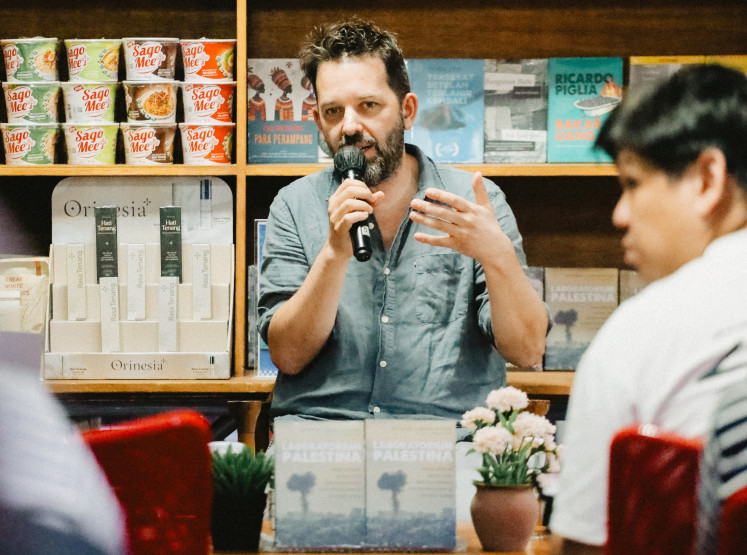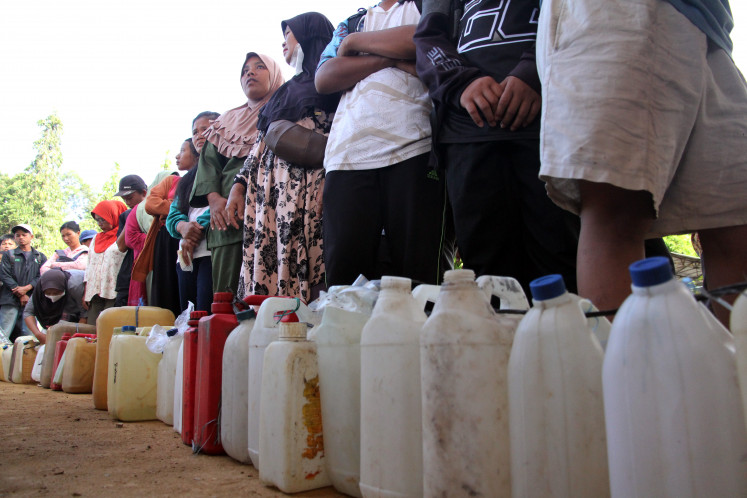Popular Reads
Top Results
Can't find what you're looking for?
View all search resultsPopular Reads
Top Results
Can't find what you're looking for?
View all search resultsAmero Jewellery launches Borobudur-inspired ‘Lavani’ collection
Local jewelry company Amero launches latest collection, inspired by the Borobudur Temple.
Change text size
Gift Premium Articles
to Anyone
Local jewelry company Amero launches its latest collection, inspired by the Borobudur Temple.
Peter Agus Wijaya, CEO of Amero Jewellery, sat cross-legged in the meadow on top of Bukit Dagi, a hill northwest of Borobudur Temple in Magelang, Central Java, on Sunday morning, Aug. 14. His eyes cast an admiring glance at the temple across the hill.
“Borobudur is magnificent,” he told The Jakarta Post. “Each nook and cranny of the temple is filled with wisdom and life’s philosophies.”
It was this Buddhist temple that has inspired the CEO to create the brand’s newest set of jewelry, Lavani - Borobudur Series, which was launched in a series of events in Magelang between Aug. 12 and 14.
A bright night: A model walks on the catwalk, during the Simfoni Lavani event, held from Aug. 12 to 14 in Magelang, Central Java. (Courtesy of Team Muara Bagdja) (Courtesy of Team Muara Bagdja/Courtesy of Team Muara Bagdja)More than a historical structure
“I was born and raised in Magelang,” Peter said. “All my friends and I have, of course, been very familiar with the Borobudur Temple. But honestly, all this time we’ve just seen it as a mere historical structure.”
It was during the COVID-19 pandemic that Peter started to explore more of the temple.
“During the pandemic, I came here [at Bukit Dagi] almost every weekend in order to feel the peace of Borobudur,” he said. “I sat at this exact same spot and talked to the people working in this area. They’ve made me see the temple in a new light.”
The largest Buddhist temple in the world was built by the Shailendra Dynasty of the Ancient Mataram Kingdom circa 750 AD. Its walls are adorned with sculptures and reliefs that tell the teachings of Buddha. Many people living in its surroundings have adopted these teachings as their life philosophy.
A local guide also took Peter around the compound and helped him understand more of the temple’s architectural design and sculptures.
“The temple is made of stacks of lava stones, which are held together with an ekor burung [dovetail] system,” said Dariyat, the local guide. “Each and every stone was cut to size, transported to the site and put together without using any adhesives. The dovetail [stone formation] is used to interlock the structure.
“This system reflects our ancestors’ local wisdom,” Dariyat continued. “The temple is located within the Ring of Fire, which makes it prone to earthquakes. But thanks to the system, the structure doesn’t crumble during shocks.”
The man behind the brand: Peter Agus Wijaya, the CEO of Amero Jewellery, is pictured during an interview in Bukit Dagi, Magelang, Central Java, on Aug. 14. (JP/Sylviana Hamdani) (JP/Sylviana Hamdani)Designs with a soul
Feeling inspired by Borobudur’s architecture, Peter then adopted some of its designs into the new jewelry series. As shown in the mini exhibition at Taman Lumbini Borobudur on Aug. 12, Lavani boasts a set of bangles, chains, rings and pendants, featuring the dovetail design, in a lavish combination of black and rose gold.
“Just imagine, a dovetail system connects and holds together millions of stones that make Borobudur,” Peter said. “It’s pretty much like us in Indonesia. Although we are many and diverse, we are united as one nation.”
Some of the pieces in the collection, plated with the precious and rare black rhodium, bear the porous design of Borobudur’s lava stones.
“Originally, we had wanted to use the real lava stones for the jewelry,” said Peter, who graduated from the Gemological Institute of America (GIA) in California, the United States. “But we couldn’t, because the stones are too porous and break easily when cut into small pieces. So, we’ve textured the gold to resemble the lava stones instead.
“It’s quite a long and intricate process,” Peter added. “But Indonesian artisans can do it.”
Peter started Amero Jewellery in a small workshop in Magelang in 2015 with only eight artisans. Today, the company has expanded and employed more than 200 local artisans.
“None of them have any educational background in jewelry production,” Peter said. “But they have creative thinking and willingness to work hard.”
The series has also adopted a bird’s-eye view of the Borobudur Temple into some of its pieces. A pair of dangle earrings in Lavani looks exceptionally exquisite as they feature a spherical view of the temple in black gold, encased in a twirling golden wheel.
“I’m very proud and happy to see that a notable local jewelry brand has arisen from Magelang, which was not originally known as Indonesia’s creative city like Bandung, Yogyakarta or Jakarta,” Arto Soebiantoro, a local brand activist that attended the gala event, said.
“I think Amero’s pieces are not only beautifully designed, but also carry the soul of Indonesia.”
To mark the launch of their new series, the brand also presented Simfoni Lavani (Lavani’s Symphony) a colossal show, which combined an orchestra, Javanese dances and a jewelry parade, in collaboration with the theater troupe Swara Gembira.
“The orchestra combines Western musical compositions with Titi Laras Pelog and TIti Laras Slendro pentatonic melodies, which are all original of this region,” Mas [Brother] Oi, cofounder of Swara Gembira, said.
The 60-minute show was presented onstage at Taman Lumbini Borobudur on Aug. 12, against a semi-transparent black screen, featuring the Buddhist temple in the background.
Stefania Brunettiis, founder of AXSS public relations firm from New York, was apparently impressed with the gala show.
“It’s so hard not to cry,” she said, while fighting back tears toward the end of the show. “The show is so amazing.”
Brunettiis had insisted on coming to Magelang after meeting Peter in New York earlier this year.
“When I met Peter in New York at the beginning of summer [this year], he brought me some of the pieces,” she said. “And when I put them on, I felt the power. I felt the energy, because the inspiration [for the jewelry pieces] comes from the temple, which is one of the seven wonders of the world.”
Brunettiis also plans to promote Lavani to the international world.
“The plan is to bring them internationally,” she said. “I think Amero is ready for the next step and to go out there into the world.”
School visit: A number of children learn a Javanese dance at the i-Care Academy, a non-formal school managed by Amero Jewellery. (JP/Sylviana Hamdani) (JP/Sylviana Hamdani)i-Care Academy
Amero Jewellery also manages i-Care Academy, a non-formal school for children that live in villages surrounding the Borobudur Temple.
The school was originally started by Peter’s former schoolmate, Galuh “Atik” Larasati, on a porch of a house in Tanjung Village, about 6 kilometers from Borobudur, in 2017.
“I started the school as I was getting quite concerned with the fact that fewer and fewer children wanted to practice local traditional handicrafts and unggah-ungguh [polite Javanese mannerism],” Atik said during an interview on Aug. 13.
The villages around Borobudur are known for their batik, earthenware and jamu (herbal drink) production.
Children of any age may come to the school and learn any skills that they desire directly from practitioners and local teachers that volunteer for the program.
“The concept is sinau seneng-seneng [learning while having fun],” Atik said.
With the help of Amero, the school relocated to a much bigger location in Karangrejo village, about 4 kilometers from Borobudur, in 2019. The 1,500-square-meter area has been built to resemble a traditional village with bamboo-woven huts and garden patches, featuring local vegetation.
Over the years, the lessons provided by the school have expanded to also include English, Javanese traditional dances, painting, pottery making and much more.
One of the children that regularly comes to i-Care Academy is Bayu. On Aug. 13, the 11-year-old boy from Trenggilan village learned how to make a stupa from clay.
“It’s so much fun,” Bayu said, while mashing the clay on the pottery wheel with both hands.
David Maulana, a volunteer who teaches the pottery class that day, smiled.
“Many men in nearby villages work as potters,” 27-year-old David said. “By learning how to make pottery, I hope that these children will develop a strong sense of confidence in their roots and stay away from negative influences.”
All activities in the i-Care Academy are free-of-charge.
“I believe this school also carries the values of the Borobudur, which are integrity, collaboration, responsibility and excellence,” Peter concluded.














